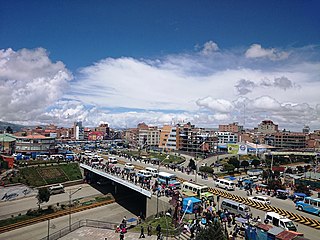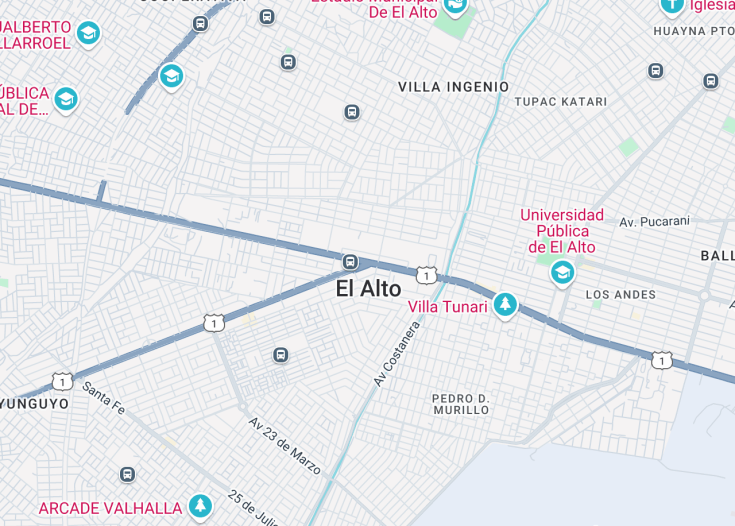Perched high above sea level, El Alto boasts a stunning overlook of the Bolivian Andes and the sprawling city of La Paz. This city, one of the highest major cities in the world, is vibrant with colorful markets, unique architecture, and a rich cultural tapestry that intertwines indigenous traditions with modern dynamics.
Its growth has been dynamic, helping it emerge as an essential hub of activity and culture in Bolivia, offering visitors a unique blend of experiences that are both urban and distinctly local.
When visiting El Alto, be sure to experience the bustling markets. They are not only a place to shop but a way to immerse yourself in the local culture and daily life.
Plan your visit to coincide with the weekly El Alto market, held every Thursday and Sunday, to experience one of the largest open-air markets in South America.
Top things to do & see in El Alto
Select the following sights and activities to discover best tickets and tours available in El Alto.
El Alto: Gateway to the Andes
| Country | Bolivia |
| Time in El Alto | GMT-4 |
| Language spoken | Spanish |
| Population | 1,184,000 (World Population Review, 2023) |
| Currency | Bolivian Boliviano (Bs, BOB) |
| Airports |
|
Perched at an astounding altitude of 4,150 meters, El Alto stands as one of the highest major cities in the world, literally touching the sky. Located just above La Paz and often considered its sister city, El Alto was once a suburb before obtaining its autonomy in 1985. This city is deeply connected to the indigenous Aymara culture, reflected in its vibrant festivals, traditional crafts, and local markets, the most famous being the sprawling open-air market at 16 de Julio, which offers everything from everyday items to artisanal goods.
El Alto is not only significant due to its cultural richness but also plays a crucial role in Bolivia’s economy. It hosts one of the largest international airports in the country, El Alto International Airport, connecting this highland area with the rest of Bolivia and international destinations. Additionally, El Alto is a vital distribution hub, due to its strategic position near major transport routes into and out of La Paz.
The urban planning and architecture in El Alto are unique; the city is renowned for its ‘cholets’ — a blending of ‘chalet’ and ‘cholo’ (a colloquial term for indigenous people), these brightly colored mansions cum event halls embody the new Andean architecture, showcasing economic ascent and cultural pride of the local Aymara people.
Despite its rapid urban expansion, El Alto proudly retains its indigenous heritage while progressively shaping its modern identity. It stands as a testament to the resilience and ambition of its people, acting as both a cultural beacon and a critical node in Bolivia’s urban network.
Where is El Alto?
El Alto is located on the Altiplano plateau, overlooking the capital city of La Paz, in western Bolivia.
Distances:
| Route | Distance by car | Time by car |
|---|---|---|
| La Paz to El Alto | 8 mi (12.9 km) | 25 min |
| Cochabamba to El Alto | 239 mi (385 km) | 6 hr 30 min |
| Santa Cruz to El Alto | 547 mi (881 km) | 15 hr |
What is El Alto famous for?
El Alto is renowned for its unique cultural vibrancy, the highest altitude of any major city globally, and the striking ‘cholets’ that are iconic to its landscape.
History
Pre-Columbian Era
The history of El Alto begins long before its formal recognition as a city. The plateau on which El Alto stands has been inhabited for thousands of years by Aymara communities. These indigenous people developed sophisticated farming techniques and social structures well adapted to the Andean environment. Their presence established the roots of El Alto’s cultural heritage, which continues to influence the city today.
1900s – The Urban Migration
The significant development of El Alto started in the 20th century, especially during the mining boom in the neighboring city of La Paz. Many migrants from rural areas moved to El Alto seeking work and better living conditions. Over the decades, it transformed from a highland village to a bustling urban area, serving both as a residential and industrial hub.
1985 – Official Foundation
El Alto was officially established as a city in 1985. This formal recognition came as a result of its rapid population growth and economic significance, independent from the city of La Paz. It marked a new phase in its development, focusing on urban planning and infrastructure.
2000s – Political and Social Activism
The early 2000s were marked by significant political activism in El Alto. The city played a pivotal role in the 2003 Gas War, demonstrating its political influence and active civil society. These events were crucial in shaping Bolivia’s political landscape and demonstrated El Alto’s capacity as a center of social mobilization.
Present Day
Today, El Alto is one of Bolivia’s largest and most dynamic cities, characterized by its young population and rapid urban expansion. The city continues to be a vital economic engine, driven by both formal industries and a vast informal sector. Its cultural vibrancy, marked by Aymara traditions mixed with modern urban influences, makes it a unique place in Bolivia.
Visit El Alto
What to see and do in El Alto
El Alto offers a blend of cultural and modern attractions that showcase its unique heritage and dynamic urban environment. Visitors can explore:
- Cholet Buildings: Iconic architectural structures designed by Freddy Mamani, reflecting Andean culture with contemporary design.
- La Ceja: The bustling heart of the city, known for its extensive markets where one can find everything from traditional textiles to local cuisine.
- El Alto Cultural Center: Engage with the art and performances that showcase the rich cultural history of the Aymara people.
Festivities and Cultures
In El Alto, the annual Carnaval is a highlight, occurring in February or March based on the Christian calendar. This event features traditional dance performances, colorful costumes, and lively parades.
Additionally, the Alasita Festival, held in January, offers a fascinating glimpse into local customs through its miniature crafts market symbolizing prosperity and dreams.
Best time to visit El Alto
The best time to visit El Alto is during the dry season from May to October. During these months, the weather is more stable, allowing for clearer skies and more enjoyable exploration of the city’s outdoor activities and events.
Is El Alto worth visiting?
El Alto is undoubtedly worth visiting for those intrigued by a blend of traditional and modern urban cultures. Its unique position high in the Andes offers stunning views and a peek into the life on the Altiplano.
The city’s vibrant market scenes, distinctive architecture, and rich cultural festivities provide a unique cultural experience that is markedly different from other Bolivian cities.










